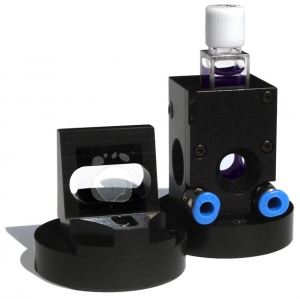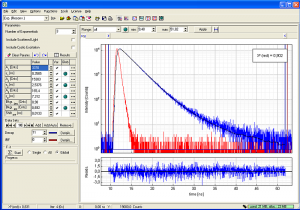Fluorescence Spectrometers
FluoTime 100 (discontinued)
Compact Fluorescence Lifetime Spectrometer
- Plug and measure, compact design
- Based on Time-Correlated Single Photon Counting (TCSPC)
- Easy to use picosecond laser or sub-nanosecond LED excitation
- Filters for high optical throughput and highest sensitivity
- Advanced data analysis
- Ideal for research and teaching purpose
The FluoTime 100 is discontinued as of April 2020.
FluoTime 100 is an easy to use, ultra compact time-resolved fluorescence spectrometer. It includes the complete optics and electronics for recording fluorescence decays via Time-Correlated Single Photon Counting (TCSPC). The system can be used with either picosecond diode lasers (LDH Series) or sub-nanosecond pulsed LEDs (PLS Series). With the FluoTime 100, decay times as short as 50 picoseconds can be resolved. The system allows operation at laser repetition rates as high as 100 MHz and count rates up to several million counts/sec.
Laser coupling module
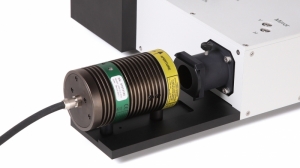 The laser coupling module consists of a holder for uncooled laser/LED heads interlocked with the detector. The holder locks the orientation of the laser head to emit either vertically or horizontally polarized radiation. The beam is directed towards the sample by an adjustable steering mirror. A mounting plate for a cooled LDH Series laser head is additionally available.
The laser coupling module consists of a holder for uncooled laser/LED heads interlocked with the detector. The holder locks the orientation of the laser head to emit either vertically or horizontally polarized radiation. The beam is directed towards the sample by an adjustable steering mirror. A mounting plate for a cooled LDH Series laser head is additionally available.
Versatile sample chamber
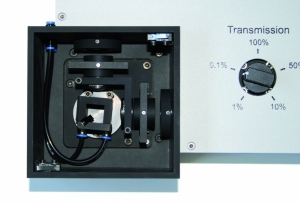 The sample chamber contains a versatile sample holder for cuvettes. Tubing for a circulating fluid is pre-installed. A front face sample holder is available as an option for small solid samples. Holders for excitation and emission filters and optional sheet polarizers are available inside the sample chamber. For security, the sample chamber lid is interlocked with the detector.
The sample chamber contains a versatile sample holder for cuvettes. Tubing for a circulating fluid is pre-installed. A front face sample holder is available as an option for small solid samples. Holders for excitation and emission filters and optional sheet polarizers are available inside the sample chamber. For security, the sample chamber lid is interlocked with the detector.
Filter wheels in excitation and emission arm
Two filter wheels are included in the spectrometer, one for regulating the intensity of excitation light, the other for selecting the spectral range of interest for detection and filtering scattered excitation light. The standard excitation filter holder contains filters of 50 %, 10 %, 1 % and 0.1 % transmission. The emission filter wheel holds various cut-off and/or bandpass filters depending on the customer’s request.
TCSPC based data acquisition
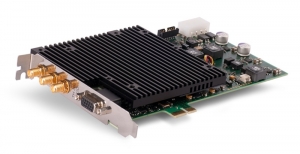 The data acquisition board (TimeHarp 260) contains the complete timing electronics for Time-Correlated Single Photon Counting (TCSPC). More than 1 million counts per second can be processed, allowing acquisition times shorter than 1 second. TimeHarp 260 covers time ranges from picoseconds to seconds thereby allowing study of fluorescence and phosphorescence with just a single instrument. All functions of the TCSPC board are controlled by an easy to use Windows based software. These functions include loading and saving of experimental data, as well as setting and storing of measurement parameters.
The data acquisition board (TimeHarp 260) contains the complete timing electronics for Time-Correlated Single Photon Counting (TCSPC). More than 1 million counts per second can be processed, allowing acquisition times shorter than 1 second. TimeHarp 260 covers time ranges from picoseconds to seconds thereby allowing study of fluorescence and phosphorescence with just a single instrument. All functions of the TCSPC board are controlled by an easy to use Windows based software. These functions include loading and saving of experimental data, as well as setting and storing of measurement parameters.
Compact photomultiplier detector
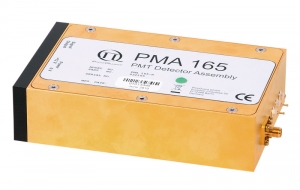 A PMA Series detector is incorporated in the FluoTime 100. The detector has a built-in high voltage power supply, signal pre-amplifier and a gold plated iron housing for optimal timing performance and maximum RF and magnetic shielding. With this detector unit, an Instrument Response Function (IRF) of less than 200 ps can be achieved in combination with a diode laser. Various different cathode types are available that cover the spectral range between 185 and 820 nm.
A PMA Series detector is incorporated in the FluoTime 100. The detector has a built-in high voltage power supply, signal pre-amplifier and a gold plated iron housing for optimal timing performance and maximum RF and magnetic shielding. With this detector unit, an Instrument Response Function (IRF) of less than 200 ps can be achieved in combination with a diode laser. Various different cathode types are available that cover the spectral range between 185 and 820 nm.
Advanced data analysis
 Acquired data can be directly transferred to the established FluoFit software for decay analysis. FluoFit features global decay analysis with an easy-to-use graphical user interface and presentation-ready numerical and graphical output. It implements an iterative reconvolution fitting routine with nonlinear error minimization. Various exponential decay models (up to fourth order including a scattered light term) or rate constant distribution models can be fitted to the observed decay in order to determine the fluorescence lifetime(s). IRF and decay background as well as time shift are included as fit parameters. Anisotropy analysis and advanced error analysis with different methods is also possible. Global analysis is also supported for all included models.
Acquired data can be directly transferred to the established FluoFit software for decay analysis. FluoFit features global decay analysis with an easy-to-use graphical user interface and presentation-ready numerical and graphical output. It implements an iterative reconvolution fitting routine with nonlinear error minimization. Various exponential decay models (up to fourth order including a scattered light term) or rate constant distribution models can be fitted to the observed decay in order to determine the fluorescence lifetime(s). IRF and decay background as well as time shift are included as fit parameters. Anisotropy analysis and advanced error analysis with different methods is also possible. Global analysis is also supported for all included models.
Course on time-resolved fluorescence
 PicoQuant annually holds the European short course on "Principles and Applications of Time-resolved Fluorescence Spectroscopy". The course is intended for individuals wishing an in-depth introduction to the principles of fluorescence spectroscopy and its applications to the Life Sciences. The course is held in cooperation with Prof. J.R. Lakowicz from the Center of Fluorescence Spectroscopy (CFS) in Baltimore and consists of lectures as well as instrumentation and software hands-on training. For details see the course website.
PicoQuant annually holds the European short course on "Principles and Applications of Time-resolved Fluorescence Spectroscopy". The course is intended for individuals wishing an in-depth introduction to the principles of fluorescence spectroscopy and its applications to the Life Sciences. The course is held in cooperation with Prof. J.R. Lakowicz from the Center of Fluorescence Spectroscopy (CFS) in Baltimore and consists of lectures as well as instrumentation and software hands-on training. For details see the course website.
The FluoTime 100 is discontinued as of April 2020.
Detailed specifications are included in the datasheet.
| Optical configuration |
|
| Mode of operation |
|
| Lifetime range |
|
| Excitation sources |
|
| Spectral separation |
|
| Detectors |
|
| Software |
|
All Information given here is reliable to our best knowledge. However, no responsibility is assumed for possible inaccuracies or omissions. Specifications and external appearances are subject to change without notice.
The FluoTime 100 is discontinued as of April 2020.
The FluoTime 100 is a compact fluorescence lifetime spectrometer. It can be used to study various samples and perform several applications, including:
- Time-Resolved Fluorescence
- Time-Resolved Photoluminescence (TRPL)
- Fluorescence Anisotropy (Polarization)
- Photochemistry
The FluoTime 100 is discontinued as of April 2020.
The following documents are available for download:
Latest 10 publications referencing FluoTime 100
The following list is an extract of 10 recent publications from our bibliography that either bear reference or are releated to this product in some way. Do you miss your publication? If yes, we will be happy to include it in our bibliography. Please send an e-mail to info@picoquant.com containing the appropriate citation. Thank you very much in advance for your kind co-operation.



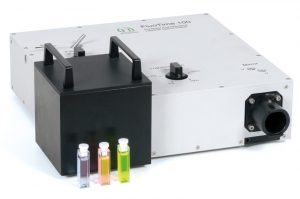
 Get in touch
Get in touch
